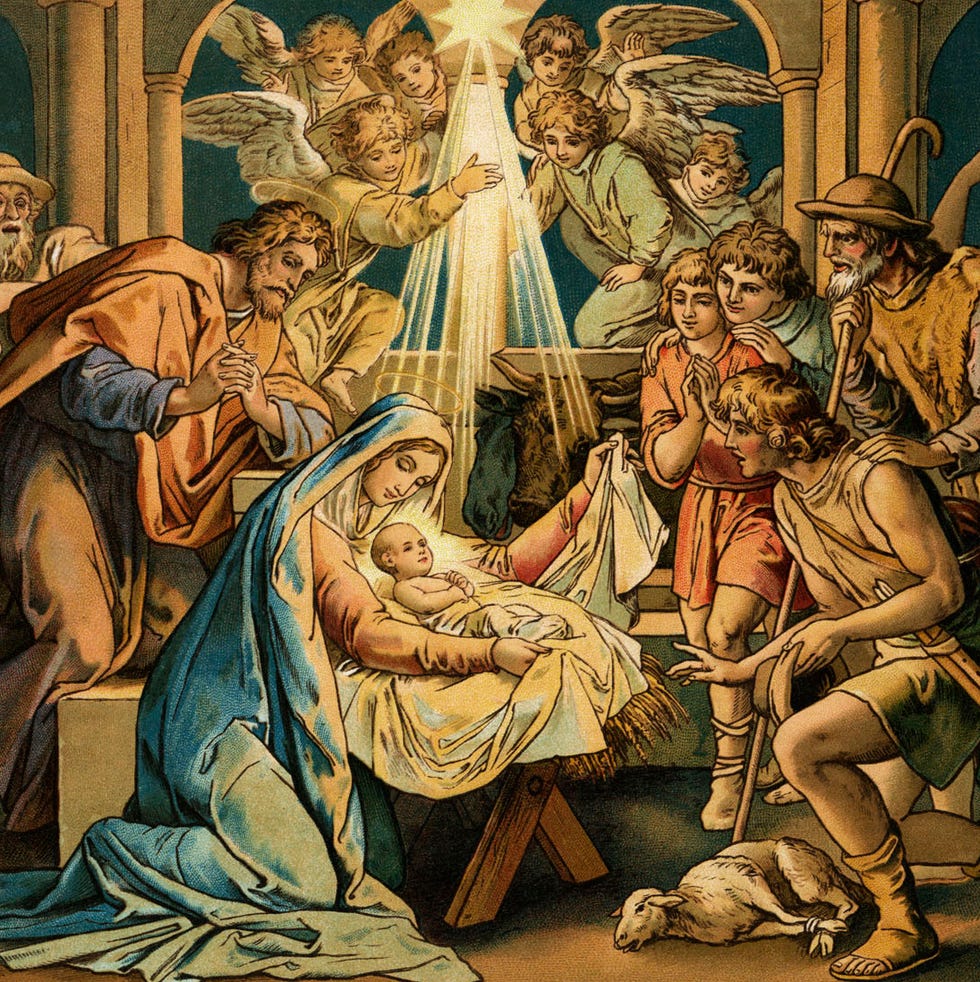| Asher Fogle, Lizz Schumer |
Christmas wasn’t always on December 25
Although Christmas celebrates the birth of Christ, it doesn’t actually mention December 25 anywhere in the bible. In fact, some historians think Jesus was born in the spring, not the winter at all! Christmas on December 25th wasn’t celebrated until about 336 AD.
Gifts have both Christian and Pagan origins

For Christians, gift giving at Christmas mimics the presents the Wise Men gave to Jesus and the charitable giving of the ancient St. Nicholas (the forerunner to Santa!). However, winter gift giving also has its roots in Saturnalia, a pagan holiday where they gave offerings to the gods.
Advertisement – Continue Reading Below
Evergreens are an ancient tradition

The iconic Christmas tree has a lot of roots (forgive the pun). Ancient Egyptians used to mark the winter solstice by decorating their homes with green palms, while the Romans celebrated Saturnalia with evergreen boughs. These green plants signified that the spring would return with new life. The first Christmas trees as we know them today started in Germany in the 16th century
You can thank Prince Albert for your Christmas tree

Christmas trees have German roots, but they really took off in popularity thanks to Queen Victoria and her husband, German Prince Consort Albert. In 1848 they were sketched standing in front of their tree with their children by the Illustrated London News, which quickly made Christmas trees fashionable.
Advertisement – Continue Reading Below
St. Nick was more generous than jolly

Coca-Cola played a part in Santa’s image

Santa wasn’t always the jolly man in red. Older depictions of Santa from the early 1900s depicted him more sternly, and there wasn’t a standardized “look” for his appearance. The classic image of a happy and plump Santa that we all know today came in part from Coca-Cola ads, drawn in 1931 by illustrator Haddon Sundblom.
Advertisement – Continue Reading Below
Hanging stockings started by accident

The historic St. Nicholas heard about the plight of a local man who did not have enough dowry money to marry off his three daughters. The generous St. Nick tossed some money down the chimney that landed in the ladies’ stockings that were drying by the fire. After that, the tradition stuck!
Rudolph was a marketing ploy

The beloved reindeer was created by a copywriter for the Montgomery Ward department store in 1939. He wrote Rudolph into a children’s story that could be given out to promote the store. It was a huge hit, with more than 2.4 million copies distributed in its first year! In 1949 Gene Autry recorded the famous song “Rudolph the Red-Nosed Reindeer,” and in 1964 came the movie featuring the island of misfit toys.
Advertisement – Continue Reading Below
The eight tiny reindeer have had lots of names

Christmas wreaths are religious symbols

Advertisement – Continue Reading Below
“Jingle Bells” was originally a Thanksgiving song

Turns out, we first started dashing through the snow for an entirely different holiday. James Lord Pierpont wrote the song called “One Horse Open Sleigh” for his church’s Thanksgiving concert in the mid-19th century. Then in 1857, the song was re-released under the title we all know and love and it’s still among the most popular Christmas songs today.
RELATED: Best Christmas Songs of All Time
Astronauts broadcast “Jingle Bells” from space

Nine days before Christmas in 1965, astronauts Wally Schirra and Tom Stafford aboard the Gemini 6 told Mission Control that they saw an “unidentified flying object” about to enter Earth’s atmosphere, traveling in the polar orbit from north to south. Just as things got tense, they interrupted the broadcast with “Jingle Bells,” as Wally played a small harmonica accompanied by Tom shaking a handful of small sleigh bells.
Advertisement – Continue Reading Below
“Silent Night” is the most recorded song

Celebrating Christmas used to be illegal

From 1659 to 1681, anyone caught making merry in the colonies would face a fine for celebrating. The Massachusetts Bay Colony created the Penalty for Keeping Christmas. It was thought that “such festivals as were superstitiously kept in other countries” and were “a great dishonor of God and offense of others. The penalty for breaking the law was five shillings.
By the Revolutionary War, the day had so little significance that Congress even held their first session on December 25, 1789. Christmas wasn’t even proclaimed a federal holiday for almost another century, proving that the Grinch’s attitude toward the holiday was alive and well long before he was.
RELATED: Here’s How People Celebrate Christmas All Over the World
Advertisement – Continue Reading Below
It’s rumored that eggnog originated in medieval Britain

Although there’s no official confirmation on who invented eggnog, most historians agree that eggnog originated in medieval Britain. Eggnog was an upper-class luxury since they were the only ones who had access to the milk, sherry and eggs required to create the original version. Monks in the Middle Ages added figs and eggs and called the drink”posset” while the wealthy kept with the simple recipe and used it for toasts or big events. Research shows that eggnog most likely became associated with the holidays due to a lack of refrigeration. It became a drink for the more common man in America because of the larger farming opportunities and more access to cows and chickens.
RELATED: Boozy Christmas Cocktails That Are Sure To Get You Into the Christmas Spirit
Christmas decorating sends nearly 15,000 people to the ER

If you’ve ever watched Clark Griswold decorate his house in Christmas Vacation this stat likely doesn’t shock you. In fact, the Consumer Product Safety Commission‘s most recent news release estimates that 14,700 people visit hospital emergency rooms each November and December from holiday-related decorating accidents — which is about 240 injuries per day. The most common accidents involve falling, lacerations and back strains.
RELATED: DIY Christmas Decoration Ideas
Advertisement – Continue Reading Below
Santa has his own Canadian postal code

Every year, letters to Santa Claus flood post offices across the world. Cementing their reputation as some of the nicest people ever, some big-hearted Canadian post office workers started writing back. As the program took off, they set up a special postal code for Santa as part of a Santa Letter-Writing Program initiative: HOH OHO.
Dry Christmas trees spark more than joy

Neglected, dried-out Christmas trees spark about 260 fires in the United States each year resulting in an average of 12 deaths, 24 injuries and $16.4 million in property damage, according to the Electrical Safety Foundation. An additional 150 fires are started because of holiday lights and other decorative lighting, resulting in an average of eight deaths, 16 injuries and $8.9 million in property damage per year. Not only will an errant spark ruin your holiday, it can put both residents and responding firefighters in danger.
RELATED: The Best Artificial Christmas Trees, According to Testing
Advertisement – Continue Reading Below
We ship a ton of packages at the holidays

Last year, the U.S. Postal Service processed more than 11.7 billion pieces of mail and packages during the holiday season. That includes gifts for loved ones, holiday cards, Christmas letters to Santa and of course, those dreaded credit card bills from all the gift shopping.
The term “Xmas” dates back to the 1500s

Contrary to popular belief, “Xmas” is not a trendy attempt to “take Christ out of Christmas”. “Christianity” was spelled “Xianity” as far back as 1100. X, or Chi, is the Greek first letter of “Christ” so “X” and back in the fourth century, Constantine the Great often referenced the shorthand version. Some say it was as early as 1021 that the abbreviation “XPmas” was used to reference the holiday, which was later shortened to “Xmas.”

When she’s not hunting for compelling personal stories or justifying her love for dessert, Asher can likely be found watching early-2000s TV on Netflix with her husband. She believes that turquoise pots create tastier meals, iced coffee and power tools make her unstoppable, and one can never have too many books.

Lizz (she/her) is a senior editor at Good Housekeeping, where she runs the GH Book Club, edits essays and long-form features and writes about pets, books and lifestyle topics. A journalist for almost two decades, she is the author of Biography of a Body and Buffalo Steel. She also teaches journalism as an adjunct professor at New York University’s School of Professional Studies and creative nonfiction at the Muse Writing Center, and coaches with the New York Writing Room.
Advertisement – Continue Reading Below
Advertisement – Continue Reading Below
Advertisement – Continue Reading Below

